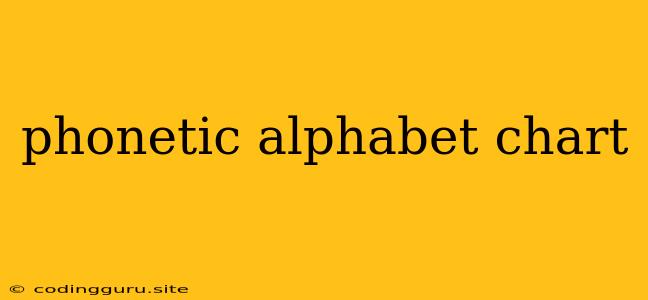Decoding the Sounds: A Comprehensive Guide to the Phonetic Alphabet Chart
Have you ever encountered a word that seems impossible to pronounce? Or perhaps you've been trying to learn a new language and found yourself struggling with the sounds of unfamiliar letters? This is where the phonetic alphabet chart comes in.
The phonetic alphabet chart, also known as the International Phonetic Alphabet (IPA), is a system of symbols that represent all the sounds found in human languages. It's like a universal language for pronunciation, offering a standardized way to record and transcribe speech sounds. But how does it work, and why is it so important?
Why Use the Phonetic Alphabet Chart?
Imagine trying to describe the sound of "th" in "thin" without actually speaking it. It's quite difficult! The phonetic alphabet chart solves this problem by providing unique symbols for each sound, regardless of the language. This is especially helpful for:
- Learning new languages: It helps you understand how words are actually pronounced, rather than relying on written spellings that can be misleading.
- Understanding pronunciation in dictionaries: Many dictionaries use IPA symbols to show the correct pronunciation of words.
- Transcribing speech for research or documentation: Linguists and speech therapists rely heavily on the phonetic alphabet chart to record and analyze speech patterns.
- Improving your own pronunciation: By practicing with the phonetic alphabet chart, you can gain a deeper understanding of how to produce different sounds accurately.
Decoding the Chart: A Closer Look
The phonetic alphabet chart might look intimidating at first glance, but it's actually quite simple. It's organized by the position of the mouth and tongue when making a sound:
- Consonants: These sounds are produced by obstructing airflow in the mouth. The chart is divided into categories based on where the obstruction occurs (e.g., lips, teeth, tongue).
- Vowels: These sounds are produced with no obstruction of airflow. The chart shows the position of the tongue in the mouth (e.g., high, low, front, back).
Each symbol on the phonetic alphabet chart represents a single sound. This means that a single letter in a word can be represented by multiple symbols if it has multiple pronunciations. For example, the letter "c" in "cat" has a different sound than the "c" in "city".
Tips for Using the Phonetic Alphabet Chart
Here are some tips to help you navigate the phonetic alphabet chart:
- Start with the basics: Focus on the most common sounds and gradually work your way to more complex ones.
- Use online resources: There are many free resources available online that provide interactive phonetic alphabet chart tools and explanations.
- Practice, practice, practice: The key to understanding and using the phonetic alphabet chart is to practice regularly. You can do this by reading texts in IPA or practicing pronouncing words based on their IPA transcriptions.
- Don't be afraid to ask for help: If you encounter difficulties, don't hesitate to ask a teacher, tutor, or language expert for guidance.
The Importance of the Phonetic Alphabet Chart in Language Learning
The phonetic alphabet chart is a valuable tool for anyone interested in languages, whether you're a beginner or an advanced learner. Here's how it can enhance your language learning journey:
- Accurate pronunciation: The phonetic alphabet chart allows you to learn the correct pronunciation of words from the very beginning, helping you avoid developing bad habits.
- Improved listening comprehension: By understanding the sounds of a language, you'll be better equipped to distinguish between similar-sounding words and understand spoken conversations.
- Increased confidence in speaking: Knowing how to pronounce words correctly boosts your confidence and improves your overall communication skills.
Conclusion
The phonetic alphabet chart is a powerful tool for language learning and understanding pronunciation. By taking the time to learn its symbols and practice, you can unlock a world of possibilities for improving your language skills and expanding your linguistic horizons. So, don't be intimidated by its appearance; dive in and discover the fascinating world of sounds!
